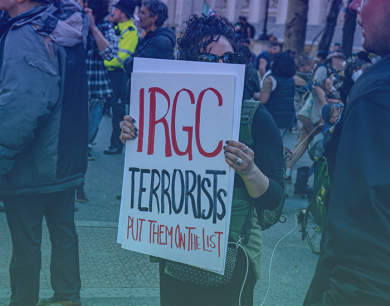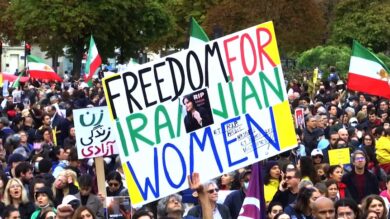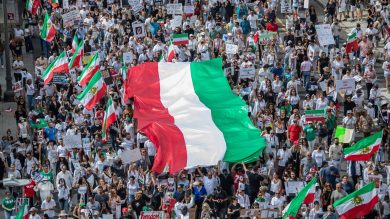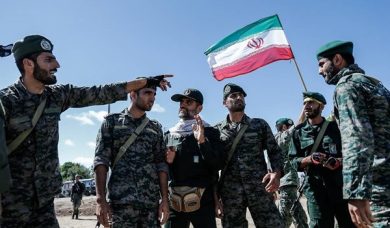In the Islamic Republic of Iran, no group symbolizes resistance to authoritarian control more powerfully than women. For over four decades, Iranian women have stood at the front lines of civil defiance—demanding autonomy, dignity, and equality. Yet standing against them is one of the regime’s most powerful institutions: the Islamic Revolutionary Guard Corps (IRGC). As the regime’s ideological and military backbone, the IRGC has played a central role in denying women their rights and violently suppressing their freedom.
This article explores the IRGC’s systematic repression of women in Iran—its mechanisms, ideologies, and methods of enforcement—while amplifying the stories of those who have resisted and paid a heavy price. From hijab laws to political imprisonment, from protest movements to forced exile, the IRGC has waged a calculated war against women’s freedom. But Iranian women have fought back—bravely, consistently, and globally.
1. The Gender Ideology of the IRGC
The IRGC was established to defend the ideals of Iran’s 1979 Islamic Revolution. Among those ideals is a strict interpretation of Shi’a Islam that reduces a woman’s role to motherhood, obedience, and modesty.
Women are viewed not as equal citizens but as vessels of family and national honor—responsible for upholding Islamic morality. This worldview justifies the IRGC’s actions against women who speak, dress, or act outside the bounds of what the regime deems acceptable.
2. Enforcement of Compulsory Hijab
One of the most visible and controversial symbols of state control over women is the mandatory hijab law. The IRGC, through its affiliations with the morality police (Gasht-e Ershad) and Basij militias, is central to enforcing this law.
Tactics include:
• Street patrols that arrest women deemed “improperly veiled”
• Surveillance via CCTV and social media to track unveiled women
• Interrogation and psychological abuse in custody
• Forcing women to “confess” on state TV
The death of Mahsa Jina Amini in 2022—after being detained by the morality police—sparked nationwide outrage. The IRGC quickly mobilized to crush the resulting protests, killing hundreds and arresting thousands, many of them women.
3. Targeting Women Protesters
Iranian women have led almost every major protest movement of the past two decades—from the Green Movement in 2009 to the “Woman, Life, Freedom” uprising in 2022.
The IRGC has responded with extreme brutality:
• Toomaj Salehi, a female protester, was blinded in one eye by rubber bullets.
• Dozens of women were targeted with pellet shots to their faces and genitals—a deliberate tactic meant to intimidate and punish.
• Thousands of women, including minors, were arrested and held in IRGC-run prisons, where reports of sexual assault, beatings, and solitary confinement have emerged.
Even in death, the IRGC seeks to control the narrative. Funeral gatherings for slain women are often disrupted or violently dispersed.
4. Women Political Prisoners
Many of Iran’s most prominent political prisoners are women who have defied IRGC authority through journalism, activism, or advocacy.
Notable Cases:
• Narges Mohammadi, Nobel Peace Prize winner, imprisoned multiple times for her human rights work. She has been subjected to solitary confinement, physical assault, and denial of medical care.
• Sepideh Gholian, labor activist, has spoken publicly about her torture in IRGC detention.
• Nasrin Sotoudeh, human rights lawyer, sentenced to 38 years and 148 lashes for defending women’s rights.
These women are not exceptions—they are part of a larger system of repression where the IRGC uses imprisonment as both punishment and deterrent.
5. Cyber Surveillance and Intimidation
The IRGC maintains a powerful cyber division that tracks women’s online behavior, including:
• Instagram photos without hijab
• Posts about feminism or human rights
• Encrypted chats in support of protests
Women are summoned, detained, and forced to delete their posts—or worse. Some are blackmailed with leaked private photos; others lose jobs or educational opportunities. IRGC agents also create fake female profiles to infiltrate activist circles and entrap dissenters.
6. Economic and Educational Discrimination
The IRGC also enforces gender apartheid through economic and institutional mechanisms:
• Gender quotas restrict women’s enrollment in university programs.
• IRGC-affiliated businesses frequently blacklist women associated with protests or dissent.
• Women are barred from high-ranking jobs in the judiciary, security forces, and government.
• In many workplaces, mandatory dress codes are policed by IRGC proxies.
This structural inequality keeps women dependent and vulnerable—a deliberate form of control.
7. Sexual Violence as a Weapon
Perhaps the most horrifying aspect of the IRGC’s war on women is the systematic use of sexual violence during detention.
Survivors have testified to:
• Rape and sexual assault during interrogation
• Forced virginity tests
• Threats of rape against family members
• Filming of abuse to use as blackmail
These tactics are not random—they are tools of psychological warfare, used to break women’s spirits and silence their resistance.
8. Suppression of Women’s Organizations
Independent women’s organizations are banned under Iranian law. Those that exist are either IRGC-controlled or operate underground.
The IRGC ensures:
• NGO licenses are denied to feminist groups.
• Leaders are arrested under “national security” charges.
• Funding is blocked, and foreign contacts are criminalized.
Despite these obstacles, women-led networks have formed around labor rights, legal support, and underground education—often at great personal risk.
9. The Role of the Basij in Universities
Within Iran’s education system, the Basij—an IRGC affiliate—operates as a moral police and ideological enforcer.
On Campus:
• Female students are surveilled for dress code violations.
• Women’s political clubs are disbanded.
• Professors who support gender equality are fired or arrested.
• Mixed-gender study groups or protests are forcibly dispersed.
The university, once a space of intellectual liberation, has become a frontline in the IRGC’s campaign to silence women.
10. Women in the Arts and Media
The IRGC heavily censors female voices in film, music, literature, and media. Women artists who defy moral codes or challenge gender norms are often targeted.
• Female singers are banned from public performances.
• Women filmmakers are harassed or denied funding.
• Actresses face dress code policing and blacklisting.
• Social media influencers are arrested for posting unveiled photos or dancing.
Some artists have fled the country; others, like Taraneh Alidoosti, have chosen to stay and face repression head-on.
11. Forced Exile and Transnational Repression
Many Iranian women have been forced into exile to escape IRGC persecution. But even abroad, they are not safe.
• Masih Alinejad, a U.S.-based journalist, was the target of multiple IRGC kidnapping and assassination plots.
• Exiled women face cyberattacks, online smear campaigns, and threats to family members in Iran.
• IRGC agents infiltrate diaspora communities to surveil and intimidate outspoken women.
These women continue their activism from exile, forming a global resistance network that challenges the IRGC’s narrative.
12. The “Woman, Life, Freedom” Movement
In response to decades of IRGC oppression, Iranian women launched a revolutionary slogan that captured the world’s attention:
“Zan, Zendegi, Azadi” — Woman, Life, Freedom.
It began as a protest against compulsory hijab, but quickly evolved into a comprehensive call for dignity, bodily autonomy, and regime change. Women led sit-ins, cut their hair in defiance, removed their hijabs, and stood unarmed against armed men.
The IRGC responded with:
• Mass arrests and detentions
• Targeted killings
• Internet blackouts
• Psychological warfare
But despite the crackdown, the movement persists—inside Iran and across the Iranian diaspora.
13. Global Solidarity and International Action
Iranian women’s bravery has inspired international support. Yet, many governments remain cautious, failing to take decisive action against the IRGC.
What Needs to Happen:
• Terrorist designation of the IRGC in more countries
• Sanctions targeting IRGC leaders and entities that repress women
• Support for women-led NGOs and safehouses
• Granting asylum and protection to female refugees and dissidents
This is not just an Iranian issue—it is a global human rights crisis.
14. The Price of Resistance—and the Power of Hope
Despite everything—the arrests, the violence, the executions—Iranian women continue to rise. Their courage is reshaping the future of Iran and inspiring movements worldwide.
They are not victims; they are vanguards.
They are not just fighting the IRGC; they are fighting for a world in which no woman has to beg for basic rights, live in fear, or be silenced.
Conclusion: A Battle That Defines a Nation
The struggle between Iranian women and the IRGC is more than a clash over clothing or law—it is a battle over identity, sovereignty, and the soul of a nation. It pits a brutal, ideological military force against a population of fierce, resilient, visionary women.
Join Our Newsletter!
Stay informed with the latest updates, news, and ways to take action in the fight for justice and global security. Sign up now to get updates delivered straight to your inbox!





